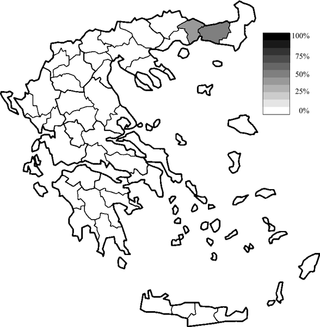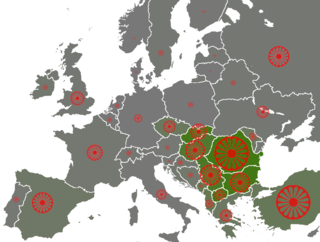
A diaspora is a population that is scattered across regions which are separate from its geographic place of origin. The word is used in reference to people who identify with a specific geographic location, but currently reside elsewhere.

Demographic features of the population of Hungary include population density, ethnicity, education level, health of the populace, economic status, religious affiliations and other aspects.

Northern Epirus is a term used to refer to those parts of the historical region of Epirus, in the western Balkans, which today are part of Albania. The term is used mostly by Greeks and is associated with the existence of a substantial ethnic Greek minority in the region. It also has connotations with irredentist political claims on the territory on the grounds that it was held by Greece and in 1914 was declared an independent state by the local Greeks against annexation to the newly founded Albanian principality. The term is typically rejected by most Albanians for its irredentist associations.
Cham Albanians or Chams, are a sub-group of Albanians who originally resided in the western part of the region of Epirus in southwestern Albania and northwestern Greece, an area known among Albanians as Chameria. The Chams have their own particular cultural identity within Albanian sub-groups. A number of Chams contributed to the Albanian national identity and played an important role in starting the renaissance of the Albanian culture in the 19th century. The Chams speak their own dialect of the Albanian language, the Cham Albanian dialect, which is a Southern Tosk Albanian dialect and one of the two most conservative ones; the other being Arvanitika.

The Greek diaspora, also known as Omogenia, are the communities of Greeks living outside of Greece and Cyprus. Such places historically include Albania, North Macedonia, parts of the Balkans, southern Russia, Ukraine, Asia Minor, Sudan, the region of Pontus, Eastern Anatolia, Georgia, the South Caucasus, Egypt, southern Italy, and Cargèse in Corsica. The term also refers to communities established by Greek migration outside of these traditional areas; such as in Australia, Chile, Canada and the United States.

Muhacir or Muhajir are the estimated 10 million Ottoman Muslim citizens, and their descendants born after the onset of the dissolution of the Ottoman Empire, mostly Turks but also Albanians, Bosniaks, Greek Muslims, Circassians, Crimean Tatars, Pomaks, Serb Muslims, Adjarians, and Muslim Roma who emigrated to East Thrace and Anatolia from the late 18th century until the end of the 20th century, mainly to escape ongoing persecution in their homelands. Today, between a quarter and a third of Turkey's population of 85 million have ancestry from these Muhacirs.

Delvinë ; is a town and a municipality in Vlorë County, southern Albania, 16 kilometres northeast of Saranda. It was formed in the 2015 local government reform by the merger of the former municipalities Delvinë and Vergo, which became municipal units. The seat of the municipality is the town Delvinë. The total population is 7,598, in a total area of 183.01 square kilometres. The population of the former municipality in the 2011 census was 5,754.

Bulgaria–Greece relations refer to bilateral relations between Bulgaria and Greece.

The Muslim minority of Greece is the only explicitly recognized minority in Greece. It numbered 97,605 according to the 1991 census, and unofficial estimates ranged up to 140,000 people or 1.24% of the total population, according to the United States Department of State.
Greek refugees is a collective term used to refer to the more than one million Greek Orthodox natives of Asia Minor, Thrace and the Black Sea areas who fled during the Greek genocide (1914-1923) and Greece's later defeat in the Greco-Turkish War (1919–1922), as well as remaining Greek Orthodox inhabitants of Turkey who were required to leave their homes for Greece shortly thereafter as part of the population exchange between Greece and Turkey, which formalized the population transfer and barred the return of the refugees. This Convention Concerning the Exchange of Greek and Turkish Populations was signed in Lausanne, on January 30, 1923 as part of the peace treaty between Greece and Turkey and required all remaining Orthodox Christians in Turkey, regardless of what language they spoke, be relocated to Greece with the exception of those in Istanbul and two nearby islands. Although the term has been used in various times to refer to fleeing populations of Greek descent, the population strength and the influence of the Asia Minor Greeks in Greece itself, has attached the term to the Anatolian Greek population of the early 20th century. At least 300,000 Greek refugees were from Eastern Thrace, whereas at least 900,000 were from Asia Minor. At least 150,000 were from Istanbul, who left the city in three years before 1928.

Bulgarians are one of the thirteen officially recognized ethnic minorities in Hungary since the Rights of National and Ethnic Minorities Act was enacted by the National Assembly of Hungary on 7 July 1993. They number 2,316 and amount to 0.02% of the country's total population according to the 2001 census, but are estimated between 2,000 and 7,000 according to different authors.

The Romani people have several distinct populations, the largest being the Roma and the Calé, who reached Anatolia and the Balkans in the early 12th century, from a migration out of the Indian subcontinent beginning about 1st century – 2nd century AD. They settled in the areas of present-day Turkey, Greece, Serbia, Romania, Croatia, Moldova, Bulgaria, North Macedonia, Hungary, Albania, Kosovo, Bosnia and Herzegovina, Czech Republic, Slovenia and Slovakia, by order of volume, and Spain. From the Balkans, they migrated throughout Europe and, in the nineteenth and later centuries, to the Americas. The Roma population in the United States is estimated at more than one million.
The Greek Operation was an organised mass persecution of the Greeks of the Soviet Union that was ordered by Soviet leader Joseph Stalin, primarily motivated by widespread distrust of Greek populations living in the Black Sea Region and also for the availability of resources. Greeks often use the term "pogrom" (πογκρόμ) for this persecution. It began on December 15, 1937, and marked the beginning of the repressions against Greeks that went on for 13 years. Depending on the sources, it is estimated that between 15,000 and 50,000 Greeks died during this campaign. Tens of thousands more were persecuted during the Deportation of the Soviet Greeks. Some scholars characterize the operation as a "genocide" against Greeks.
The Greeks of Albania are ethnic Greeks who live in or originate from areas within modern Albania. After ethnic Albanians, they form the second largest ethnic group in the country. They are mostly concentrated in the south of the country, in the areas of the northern part of the historical region of Epirus, in parts of Vlorë County, Gjirokastër, Korçë and Berat County. The area is also known as Northern Epirus. Consequently, the Greeks hailing specifically from Southern Albania are also known as Northern Epirotes. The Greeks who live in the "minority zones" of Albania are officially recognised by the Albanian government as the Greek National Minority of Albania.

Relations between Hungary and Serbia, or Serbo-Hungarian relations form a part of the wider politics of Central and Southeast Europe. The two countries have a long relationship stretching back to the Middle Ages. History of official diplomatic relations of Hungary and Serbia dates back to 21 November 1882, when they were established between the Kingdom of Serbia and Austria-Hungary. Today, Hungary has an embassy in Belgrade and a general consulate in Subotica, while Serbia has an embassy in Budapest and an honorary consulate in Szeged.
Bulgarians in Turkey form a minority of Turkey. They are Bulgarian expatriates in Turkey or Turkish citizens was born there of full or partially Bulgarian descent. People of Bulgarian ancestry include a large number from the Pomak and a very small number of Orthodox of ethnic Bulgarian origin. Bulgarian Christians are officially recognized as a minority by the Turkey-Bulgaria Friendship Treaty of 18 October 1925.

The Turks in Europe refers to ethnic Turks living in Europe. Generally, the Euro-Turks refers to the large Turkish diasporas living in Central and Western Europe as well as the historic Turkish minorities living in the Balkans since Ottoman rule, and the Turks living in Russia and other European Post-Soviet states. When the term "Euro-Turks" is taken in its most literal sense, Turkish people living in the European portion of Turkey are also included in the term. Even more broadly, the Turkish Cypriot community for centuries old native people living in Cyprus have also been defined under the term "Euro-Turks" since the island joined the European Union.
Poliçan is a village in Gjirokastër County, southern Albania. At the 2015 local government reform it became part of the municipality Dropull. It is within the wider Pogoni region that stretches in both Greece and Albania. Poliçan was the municipal center of the former Pogon commune in Albania. It is nicknamed "the Bride of the Pogoni region" and is inhabited by ethnic Greeks.
Ukrainians in Serbia refers to a Ukrainian ethnic minority in Serbia. They are officially recognized as an independent and full-fledged national minority, which is represented through the National Council of the Ukrainian National Minority. They mostly live in the region of Vojvodina, in the areas of Bačka and Syrmia. They speak Ukrainian and use Ukrainian Cyrillic script. According to the 2011 census, 4,903 members of the Ukrainian minority live in Serbia, which is 0.07% of the total population. The most important cultural and educational organization of Ukrainians in Serbia is the Society for Ukrainian Language, Literature and Culture "Prosveta" (Prosvita).
The Aromanian diaspora is any ethnically Aromanian population living outside its traditional homeland in the Balkans. The Aromanians are a small Balkan ethnic group living scattered throughout Albania, Bulgaria, Greece, North Macedonia, Romania and Serbia. Historically, they also used to live in other countries such as Bosnia and Herzegovina and Croatia, although they have ever since been assimilated.












